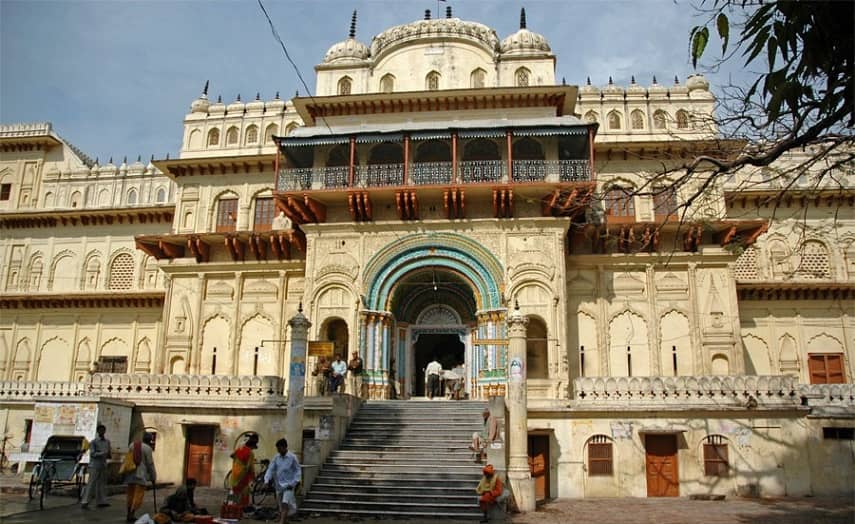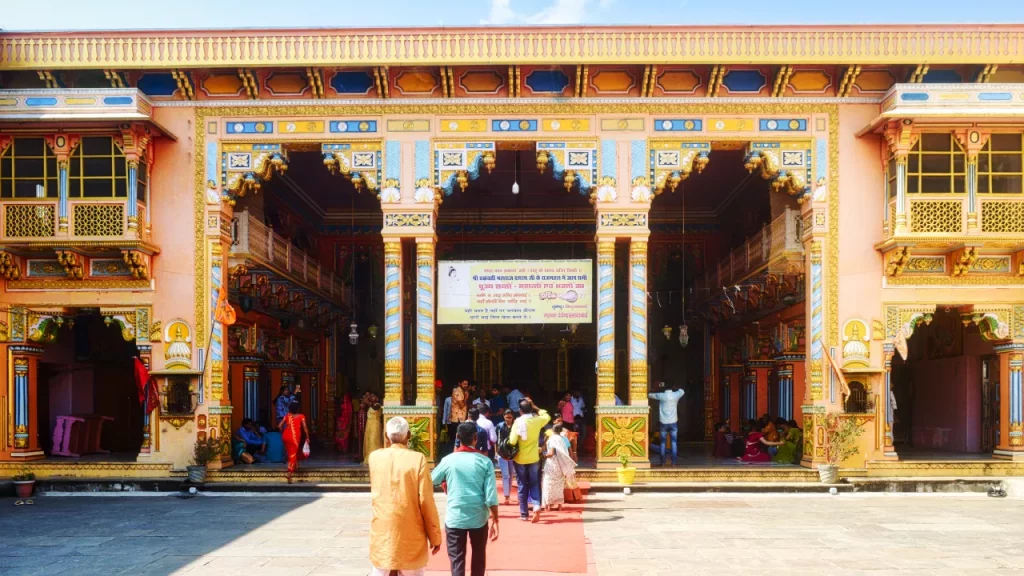Yes, Ayodhya is indeed a tourist place, but it’s more than just that.
It’s a sacred destination steeped in history, spirituality, and cultural significance.
While primarily known for its profound ties to Hindu mythology and the birthplace of Lord Ram, Ayodhya offers visitors a rich tapestry of experiences beyond religious pilgrimage.
1. Ayodhya Ram Mandir:

Ayodhya Ram Mandir stands as a testament to the rich heritage and spiritual significance of Ayodhya.
As the birthplace of Lord Ram, it holds immense religious importance for millions of devotees worldwide.
The temple complex, adorned with intricate carvings and sculptures, offers visitors a glimpse into the ancient architectural prowess of India.
Pilgrims flock to this sacred site year-round, seeking blessings and divine grace.
Ayodhya Ram Mandir truly encapsulates the essence of Ayodhya as a pilgrimage destination and a beacon of faith for Hindus.
2. Hanumangarhi:

Perched atop a hill overlooking the city, Hanumangarhi is a revered pilgrimage site dedicated to Lord Hanuman.
The temple complex, with its sprawling courtyards and majestic architecture, offers panoramic views of Ayodhya’s landscape.
Visitors can climb the 76-step stairway to reach the main entrance, symbolizing their ascent to spiritual enlightenment.
Hanumangarhi holds a special place in Ayodhya’s cultural heritage, serving as a symbol of devotion and resilience for devotees and travelers alike.
3. Kanak Bhawan:

Tucked away in the Ram Temple complex, Kanak Bhawan is a shining example of architectural grandeur and religious significance.
Also known as Sone-ka-Ghar, the temple is dedicated to Lord Ram and Goddess Sita.
Legend has it that Kaikeyi, Lord Ram’s stepmother, offered the temple to him and Sita as a token of her love.
The golden-crowned statues of the deities inside the temple mesmerize visitors with their divine beauty and grace.
Kanak Bhawan is a must-visit destination for those seeking to immerse themselves in the sacred atmosphere of Ayodhya.
Want to Visit Ayodhya? Put Down your name and number and we’ll contact you.
4. Nageshwarnath Temple:

Located near Theri Bazaar, Nageshwarnath Temple is dedicated to Lord Nageshwarnath, the patron deity of Ayodhya.
Built by Kush, Lord Ram’s son, the temple has stood for centuries as a symbol of faith and devotion.
Its ancient architecture and intricate carvings reflect the rich cultural heritage of Ayodhya.
Visitors flock to the temple during festivals like Mahashivaratri and Trayodashi, immersing themselves in the spiritual ambiance and divine blessings.
Nageshwarnath Temple is a sacred pilgrimage site and a testament to Ayodhya’s enduring legacy as a center of worship.
5. Treta Ke Thakur:

Nestled in Ayodhya’s Naya Ghat neighborhood, Treta Ke Thakur Temple is steeped in history and mythology.
The temple houses a collection of ancient idols, including representations of Lord Ram, Laxman, Hanuman, Sita, Bharat, and Sugreev.
Each idol, carved from a single piece of black sandstone, tells a story of devotion and reverence.
Treta Ke Thakur Temple is open to the public only on Ekadashi, the eleventh day of the Shukla Paksha in the month of Karthika, adding to its mystique and allure.
Visitors can experience colorful festivities and ancient rituals during their visit, immersing themselves in the cultural heritage of Ayodhya.
6. Choti Chawni:

Adorned in pristine white marble, Choti Chawni is a testament to Ayodhya’s architectural brilliance and cultural diversity.
Also known as Valmiki Bhawan, the complex boasts 34 historic caves, each with its own significance in Buddhism, Hinduism, and Jainism.
The presence of the Kailasha Temple within the caverns adds to the site’s allure and mystique, attracting visitors from far and wide.
Choti Chawni is a must-visit destination for those seeking to explore Ayodhya’s rich cultural heritage and ancient architecture.
7. Sita Ki Rasoi:

Located near the Ram Janmabhoomi, Sita Ki Rasoi is a unique temple dedicated to Goddess Sita.
Once a historic kitchen, the subterranean space now houses display vessels and serves as a reminder of Sita’s culinary prowess and divine grace.
The temple offers free meals to visitors, symbolizing the goddess’s role as the provider of nourishment and sustenance.
Guests can contribute to local charities through donations made at the temple, furthering the legacy of compassion and generosity associated with Sita Ki Rasoi.
Visiting this sacred site is a must for those seeking to experience the cultural and spiritual significance of Ayodhya.
Also Read: Best Time to Visit Ayodhya Hills in Purulia
8. Raja Mandir:

Situated in Guptar Ghar on the banks of the Sarayu River, Raja Mandir is a marvel of architectural splendor and religious significance.
The temple complex is adorned with exquisitely carved idols of Hindu deities, reflecting the rich cultural heritage of Ayodhya.
Devotees believe that taking a plunge into the holy waters of the river can cleanse them of their sins, adding to the site’s spiritual allure.
Raja Mandir is a must-visit destination for those seeking to explore Ayodhya’s rich history and cultural heritage.
9. Ramkatha Park:

Ayodhya’s Ram Katha Park is a serene oasis amidst the hustle and bustle of city life.
The park’s sprawling lawns and open-air theaters serve as a venue for cultural events and religious gatherings.
Visitors can immerse themselves in the retelling of ancient epics and legends, surrounded by the serene beauty of nature.
Ram Katha Park is a must-visit destination for those seeking to experience the cultural vibrancy and spiritual heritage of Ayodhya.
10. Mani Parbat:

Rising above Kami Ganj, Mani Parbat offers breathtaking views of Ayodhya’s landscape and serves as a sanctuary of peace and spirituality.
The hill is adorned with a Buddhist monastery and stupa built by Emperor Ashoka, adding to its cultural significance.
Its proximity to Sugriv Parbat adds to its allure, creating a sacred pilgrimage site for spiritual seekers.
Mani Parbat is a must-visit destination for those seeking to explore Ayodhya’s natural beauty and spiritual heritage.
11. Dashrath Bhavan:

Also known as Badi Jagah or Bada Asthan, Dashrath Bhavan is steeped in the lore of Lord Ram’s youth and the capital of King Dasharath.
The palace complex is adorned with ornate murals and saffron-clad priests, echoing with the chants and mantras of devotees.
During festivals like Karthik Mela Ram Vivah and Diwali, the palace attracts thousands of devotees, seeking blessings and divine grace.
Dashrath Bhavan is a must-visit destination for those seeking to experience the cultural and religious heritage of Ayodhya.
12. Sugriva Temple:
Situated in the vicinity of Hanumangarhi, Sugriva Temple holds significance in the narrative of Lord Ram’s return from exile.
King Bharat, Lord Ram’s brother, built the temple as a symbol of loyalty and devotion to his beloved sibling.
Visitors can witness fervent celebrations during festivals like Ramnavami and Janmashtami, experiencing the vibrant cultural traditions of Ayodhya firsthand.
Sugriva Temple is a must-visit destination for those seeking to explore Ayodhya’s religious and cultural heritage.
13. Kaale Ram Mandir:

Nestled behind the Nageshwarnath Temple, Kaale Ram Mandir is a hidden gem dedicated to the dark-complexioned form of Lord Ram.
Despite its obscurity, the temple continues to attract determined devotees, drawn by the promise of answered prayers and divine blessings.
The famous evening aarti at the temple is a testament to the unwavering faith and devotion of its visitors.
Kaale Ram Mandir is a must-visit destination for those seeking to experience the spiritual ambiance of Ayodhya.
14. Brahmakund Gurudwara:

Located east of Ram Janmabhoomi, Brahmakund Gurudwara holds historical significance as the site where Sikh warriors strategized against Mughal emperor Aurangzeb’s advances.
Visitors can explore the gurudwara’s grounds, where relics of the victorious nihang forces serve as reminders of valor and resilience.
The gurudwara’s association with Guru Nanak Devji and Guru Tegh Bahadur adds to its spiritual allure and cultural heritage.
Brahmakund Gurudwara is a must-visit destination for those seeking to explore Ayodhya’s diverse cultural heritage and religious significance.
15. Sarayu Ghat:

Concluding our journey is the serene Sarayu Ghat, where the tranquil waters of the Sarayu River offer a respite from the chaos of city life.
Visitors can witness morning and evening Aaratis, immersing themselves in the spiritual ambiance and sacred rituals.
Naya Ghar, Guptar Ghat, Ram Ghat, and Lakshman Ghat are among the many ghats frequented by devotees, each offering a unique glimpse into Ayodhya’s spiritual legacy.
Sarayu Ghat is a must-visit destination for those seeking to experience the serene beauty and spiritual heritage of Ayodhya.
In conclusion, these 15 places to visit in Ayodhya offer a comprehensive exploration of the city’s rich history, cultural heritage, and spiritual significance.
From ancient temples and historic palaces to serene riverbanks and hidden gems, each site invites travelers on a journey of discovery and enlightenment.
As you wander through the ancient streets of Ayodhya, you’re sure to be captivated by its timeless charm and enduring allure.